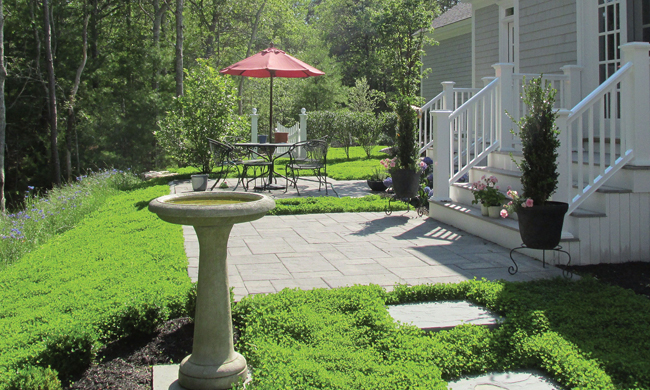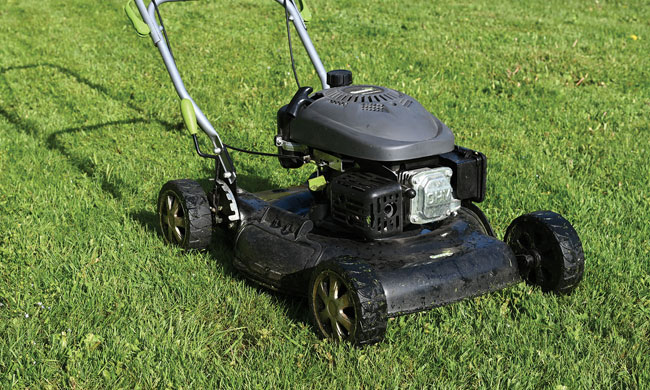Live Better
Rethink your lawn this summer

Use clover for a lush, green, eco-friendly, enviable yard
(Family Features) Who has time to continuously care for that carpet-like, green grass almost everyone longs for? Nearly no one. Cultivating a lush, green lawn takes time, can be expensive and is a mainstay on weekend to-do lists spring through fall. Now that’s a serious commitment.
Traditional turf lawns require a lot of maintenance. You must mow and remove weeds often, plus the amount of water usage can be staggering. The average American family uses 320 gallons of water per day, about 30% devoted to outdoor uses, according to the EPA. More than half of that is used for watering lawns and gardens. Nationwide, landscape irrigation is estimated to account for almost one-third of all residential water use, totaling nearly 9 billion gallons per day.
It’s about time to rethink the obsession with turf grass lawns and take a page from the past; clover can help create a great-looking lawn. Several decades ago, clover was considered so essential for lawns that it was a standard component in lawn seed mixes and wasn’t considered a weed. Clover was branded a weed when agricultural chemical companies created herbicides to rid lawns of broadleaf plants. The herbicides had no effect on grass, but killed everything else, clovers included, which is how clover became identified as a weed.
It’s not too late to renovate your lawn and reintroduce the springy, soft, green carpet of clover back into your lawn. It’s fluffy on the feet, aids in both weed and erosion control and, when used to overseed existing lawns, fills in bare spots fast.
Today, as interest grows in more natural, eco-friendly ways to care for grass, you might consider totally replacing your lawn with an option like Miniclover, which should not be confused with invasive white Dutch clover.
“Miniclover is about one-third to half the size of white Dutch clover, producing a thick, carpet-like appearance that blends well with turf,” said Troy Hake, president and owner of Outsidepride.com, which offers a multitude of seeds, including grasses, clovers, wildflowers, herbs and more. “It’s especially attractive, cost effective, eco-friendly and can help you get that thick, lush, green lawn your neighbors will envy.”
In addition to providing weed and erosion control, the fluffy lawn alternative offers a variety of benefits:
Nitrogen fixer. Miniclover takes nitrogen from the air and “fixes” it in your soil, eliminating the need to apply nitrogen plant food because it does the work for you, keeping lawns green and growing while adding natural nitrogen to the soil.
Drought tolerant. Miniclover has longer, deeper roots than turf grass, reaching down into the soil for the moisture they need, so you won’t need to water as much during normal weather conditions. Plus, it stays green year-round and is resistant to drought and tolerates wet conditions.
Controls weeds. Its dense structure and growth habits help suppress existing weeds and the establishment of new weeds, as it grows via stolons (stems that grow horizontally along the ground).
Low to no maintenance. You can mow Miniclover – the more it’s cut, the smaller the leaf size – or simply let it grow, as it only grows 4-6 inches tall and doesn’t get unwieldy, making it an ideal lawn alternative or healthy addition to your lawn.
Thrives in sun to partial shade. Unlike some turfgrass types, Miniclover does well in partial shade that receives at least some direct sunshine daily.
Stands up to foot traffic. It has superior wear tolerance over turf grass, does well in compacted soil and fills bare spots quickly.
Makes great groundcover. Grow it alone or, because of its adaptability and ability to grow in a wide variety of conditions, combine it with other groundcover plants, like creeping phlox, ivy and thyme.
It’s time to rethink typical lawn turf and try an eco-friendly alternative to replace or renovate your lawn. For more information, visit Outsidepride.com.
SOURCE:
Outsidepride.com
Live Better
Tips to make your AC more energy efficient, sustainable

(Family Features) Updating your HVAC (heating, ventilation and air conditioning) system to cool your home in a smart and sustainable way involves several steps that not only improve energy efficiency but also reduce environmental impact.
Consider these tips from the heating and cooling experts at Carrier to help make your cooling system more eco-friendly:
- Upgrade to an Energy-Efficient HVAC System. If your HVAC system is outdated, consider replacing it with a more energy-efficient model. Look for systems with an Energy Star or high SEER2 (seasonal energy efficiency ratio) rating, which indicates better energy efficiency. The higher the SEER2 rating, the more efficient the unit. Financial incentives for installing a higher-efficiency system are available through the Inflation Reduction Act of 2022. You can also shop for rebates from manufacturers and utility companies.
- Look for a Carbon-Free HVAC System. Heat pumps, ductless and VRF (variable refrigerant flow) systems that run on electricity and use low global-warming potential refrigerant, like Carrier’s Puron Advance, can help reduce your home’s negative impact on the environment.
- Install a Smart Thermostat. A smart thermostat can be programmed based on your preferences and adjust temperatures automatically. These devices can be controlled remotely through smartphones and help reduce energy consumption by cooling your home only when necessary.
- Conduct Regular Maintenance. Keep your HVAC system running efficiently with regular maintenance. This includes cleaning or replacing air filters every 1-3 months, checking refrigerant levels, cleaning outside condenser coils and ensuring the system’s components are in good, working condition and the airflow is not blocked.
- Seal and Insulate. Improve your home’s insulation to maintain a consistent temperature. Seal windows, doors and any gaps or cracks to prevent cool air from escaping. This can significantly reduce the workload on your HVAC system.
- Use Ceiling Fans. Ceiling fans can help circulate cool air throughout your home, allowing you to set the thermostat at a higher temperature without sacrificing comfort, thus saving energy.
- Add Window Treatments. Use blinds, shades or curtains to block out sunlight and reduce heat gain during the hottest parts of the day. This simple step can make a big difference in how much your air conditioner needs to work.
- Upgrade to a Variable-Speed Compressor. Traditional compressors operate at full power or not at all. However, a variable-speed compressor can adjust its output to match your cooling needs precisely, resulting in better efficiency, energy savings and improved indoor comfort.
- Ventilate Properly. Ensure proper ventilation in your home, especially in areas like the kitchen and bathroom, to remove excess heat and humidity, which can reduce the need for air conditioning.
- Update Roofing. If you’re replacing your roof, consider cool roofing materials that reflect more sunlight and absorb less heat than standard roofing materials, reducing the heat that enters your home.
By implementing these strategies, you can improve or update your HVAC system to cool your home more sustainably. Not only do these steps help the environment, they can also lead to lower energy bills and improved indoor comfort. Always consult with an HVAC professional to determine the best and most efficient options for your home and needs.
Find more information and tips to sustainably cool your home at Carrier.com.
SOURCE:
Carrier
Live Better
Steps to get your yard ready for spring

(Family Features) As the weather begins to warm and days get longer, it’s important to begin preparing your yard for a healthy growing season. While factors like climate, soil type and grass type can all impact how your yard grows, there are a few steps you can take during the spring months to help your lawn thrive.
From dethatching and aerating to fertilizing and mowing, tackling these simple chores can help ensure your yard looks its best and is prepared to fight off seasonal weeds, disease and drought.
Tune Your Mower
Before it’s time for the first mowing of the season, inspect your mower and perform any routine maintenance necessary. That goes beyond sharpening, or replacing, the blade, and includes changing the oil, spark plugs and filter as well as filling with a fresh tank of gas.
Loosen the Thatch Layer
While it’s important to avoid working on your lawn until after the final freeze to avoid damaging the grass, raking your yard with a spring tine rake to loosen thatch – the layer of leaves, roots and dead grass that builds up between live grass and soil – before the first mow is equally important. Be sure to rake when the soil is dry; if it’s too soft or muddy, you may pull up healthy grass crowns.
Combat Compacted Soil
If your soil has become compacted – likely the effect of heavy foot traffic – and is too dense for water, air and other nutrients to reach the roots of your grass, aerating can help break it up and reduce thatch. A core, or plug, aerator can introduce tiny holes into your soil by removing plugs of grass and soil, which lets nutrients more easily reach the roots. An added bonus, the plugs can decompose on top of your grass, supplying more nutrients.
Fill in Bare Spots
If your lawn is looking sparse, overseeding, which involves spreading grass seed over your existing lawn, can help fill in bare spots. Be sure to choose the right type of seed for your climate and soil type to ensure proper growth. Applying a slow-release nitrogen fertilizer at the same time can provide additional nutrients that are important for promoting healthy growth.
Start Seasonal Mowing
When the ground is dry enough and your grass is long enough to require cutting, begin seasonal mowing. Be sure to use proper techniques, including varying your mowing direction each time to avoid creating patterns or ruts, and avoid cutting grass too low, which can make the lawn more susceptible to weeds and drought stress. In general, never remove more than one-third of the grass blade at a time.
Find more tips to help get your yard ready for warm weather at eLivingtoday.com.
Photo courtesy of Unsplash
SOURCE:
eLivingtoday.com
Live Better
6 tips to improve sleep quality for overall well-being

(Family Features) Despite a rising number of people searching for the term “sleep” in 2023, nearly 1 in 3 U.S. adults report not getting enough of it, per the Centers for Disease Control and Prevention.
As a foundation for overall well-being, getting quality sleep is key to achieving goals and being present in daily life. Without it, you’re more likely to lack the stamina and energy to follow through on your ambitions.
To help people realize the foundational role sleep plays in everyday successes, Natrol – a leading sleep, mood and stress supplement brand based on Nielsen data – alongside Dr. Jess Andrade are working together to help people improve their sleep quality and habits so they can conquer their wellness goals this year and beyond.
“From consistent exercise to eating healthy and even daily journaling, it may seem like all your priorities are in order, but without sleep, you won’t be able to reap the full benefits of your hard work,” Andrade said. “Often overlooked, getting quality sleep is a fundamental piece to improving overall wellness and it doesn’t have to be complicated. Creating small, achievable changes in our daily sleep routines can lead to long-lasting lifestyle habits for the better.”
Consider these tips from Andrade to help improve your sleep quality so you can achieve your goals.
1. Prioritize Movement and Light Exposure in the Morning
Whether you’re a yogi or prefer a simple stretch when your feet hit the floor, movement and light during the day can help stimulate quality sleep later that night.
2. Understand Sleep Gains are Just as if Not More Important Than Gym Gains
If you’re focusing on fitness goals, you’ll need adequate sleep to see successful results. If you’re a morning workout warrior, schedule earlier bedtimes to ensure you get the recommended 7-8 hours of sleep. For evening workouts, aim to end your sweat session as early in the evening as possible; too much physical activity before bed can keep you up at night.
3. Make Your Bedroom a Sanctuary
Make your bedroom a sleep sanctuary. Keep the room dark, noise-free and comfortable with the thermostat set at 65-67 F for better sleep conditions.
4. Set Nightly Rituals to Unwind
Create nightly rituals that activate circadian rhythms and allow your body to unwind. Consider activities that relax you the most, like taking a bath, reading a book, journaling or sipping decaffeinated nighttime tea.
5. Try Incorporating a Drug-Free Sleep Aid
If you follow good bedtime habits but still occasionally struggle to fall or stay asleep, try a low-milligram melatonin supplement, like those from Natrol, that are designed to help you get a good night’s sleep so you wake up refreshed and ready to conquer your goals.†
6. Follow the 10-3-2-1-0 method
To help you fall asleep and wake up feeling revitalized, Andrade recommends the 10-3-2-1-0 method: Decrease caffeine intake at least 10 hours before bed. Avoid eating bothersome foods 3 hours prior to heading to off to sleep. Engage in relaxing activities like reading at the 2-hour mark and cut out screentime with 1 hour to spare. Ultimately, these habits can lead to zero times hitting snooze the next morning.
Find more ways to improve sleep habits by visiting Natrol.com.
† These statements have not been evaluated by the Food and Drug Administration. These products are not intended to diagnose, treat, cure, or prevent any disease.
SOURCE:
Natrol
-

 NEWS1 year ago
NEWS1 year ago2 hurt, 1 jailed after shooting incident north of Nocona
-

 NEWS5 months ago
NEWS5 months agoSuspect indicted, jailed in Tia Hutson murder
-

 NEWS1 year ago
NEWS1 year agoSO investigating possible murder/suicide
-

 NEWS1 year ago
NEWS1 year agoWreck takes the life of BHS teen, 16
-

 NEWS9 months ago
NEWS9 months agoMurder unsolved – 1 year later Tia Hutson’s family angry, frustrated with no arrest
-

 NEWS12 months ago
NEWS12 months agoSheriff’s office called out to infant’s death
-

 NEWS1 year ago
NEWS1 year agoBowie Police face three-hour standoff after possible domestic fight
-

 NEWS1 year ago
NEWS1 year agoDriver stopped by a man running into the street, robbed at knifepoint





